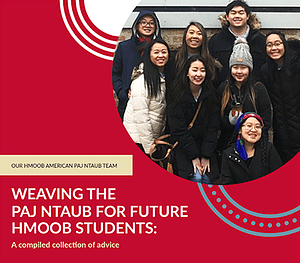 “Our HMoob American College Paj Ntaub” is an ongoing qualitative research project conducted in partnership with a student organization at UW-Madison called the Hmong American Studies Committee (HASC) that examines the sociocultural and institutional factors impacting the college experiences of HMoob American students. The term “Paj Ntaub,” or story cloth, is a narrative pictographic representation in fabric of the experiences of the HMoob people, which often address their history during the U.S. wars in Southeast Asia and as refugees. We call our study “Our HMoob American College Paj Ntaub” because this study presents the stories of the lives of HMoob American college students. The study uses interviews and observations with HMoob American college students as well as artifact data from around the University of Wisconsin-Madison campus and classrooms to better understand the college experiences of HMoob American students through their voices and lived experiences. Check out our report Our HMoob American College Paj Ntaub (PDF).
“Our HMoob American College Paj Ntaub” is an ongoing qualitative research project conducted in partnership with a student organization at UW-Madison called the Hmong American Studies Committee (HASC) that examines the sociocultural and institutional factors impacting the college experiences of HMoob American students. The term “Paj Ntaub,” or story cloth, is a narrative pictographic representation in fabric of the experiences of the HMoob people, which often address their history during the U.S. wars in Southeast Asia and as refugees. We call our study “Our HMoob American College Paj Ntaub” because this study presents the stories of the lives of HMoob American college students. The study uses interviews and observations with HMoob American college students as well as artifact data from around the University of Wisconsin-Madison campus and classrooms to better understand the college experiences of HMoob American students through their voices and lived experiences. Check out our report Our HMoob American College Paj Ntaub (PDF).
Presentations
A presentation to the Bill & Melinda Gates Foundation of a second year research study done by the Paj Ntaub Research Team. The team presents their research findings regarding the factors that have influenced UW-Madison HMoob American academic experiences, which ultimately informed their college-to-workforce pathways. In addition, their presentation demonstrates how Community Based Participatory Action Research (CBPAR) can be an innovative research practice in educational settings, as it offers a transformative experience for students as researchers and, overall, as individuals.
Research Briefs

Our HMoob American College Paj Ntaub (PDF)

 Our HMoob American College Paj Ntaub: Activating your Agency and Building Critical Consciousness through Participatory Action Research
Our HMoob American College Paj Ntaub: Activating your Agency and Building Critical Consciousness through Participatory Action Research HMoob American Undergraduate Students at University of Wisconsin’s 4-Year Comprehensive Colleges – Background, Enrollment Statistics, and Graduation Trends (PDF)
HMoob American Undergraduate Students at University of Wisconsin’s 4-Year Comprehensive Colleges – Background, Enrollment Statistics, and Graduation Trends (PDF)